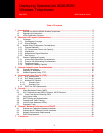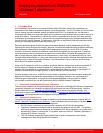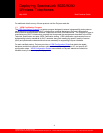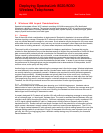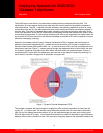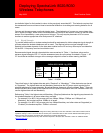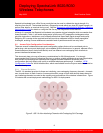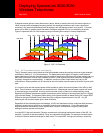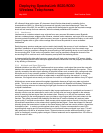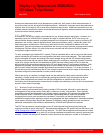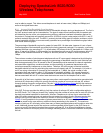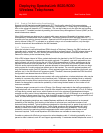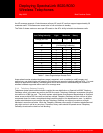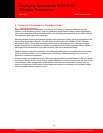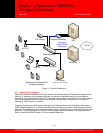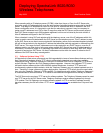
Deploying SpectraLink 8020/8030
Wireless Telephones
May 2009 Best Practices Guide
10
©2009 Polycom, Inc. All rights reserved.
Polycom and the Polycom logo are registered trademarks of Polycom, Inc. All other trademarks are the property of Polycom, Inc. or their respective companies.
AP utilizes all three radios types, AP placement should first be determined by modeling for the
characteristics of 802.11a, since this environment will typically have the shortest range. Then, th
transmit power of the 802.11b and 802.11g radios should be adjusted to provide the required cove
levels and cell overlap for those networks, within the already established AP locations.
e
rage
.2.3 Interference
s network may originate from many sources. Microwave ovens, Bluetooth
ong
adio frequency spectrum analyzers can be used to help identify the sources of such interference. Once
ith
documented facility-wide radio frequency usage policy will help control sources of RF energy. Ideally,
.2.4 Multipath and Signal Distortion
nce that occurs when a radio signal has more than one path
signal.
ultipath can cause severe network throughput degradation because of high error rates and packet
s.
P diversity antennas should always be used to help improve performance in a multipath environment. A
ept
ill
o
2
Interference on a wireles
devices, cordless phones, wireless video cameras, wireless motion detectors, and rogue APs are am
the many potential interfering RF (radio frequency) sources. In general, devices that employ or emit radio
frequency signals within a given radio coverage area will have the potential to cause unwanted
interference.
R
identified, interference is best mitigated by removing the interfering device(s) from the network area.
Otherwise, it may be possible to change the channel setting of the interfering device to avoid conflict w
the surrounding APs. If this is also not possible, then it may be possible to change the channel of the
surrounding APs to avoid as much radio frequency overlap with the interfering device.
A
any RF generating device should have prior approval before introduction onto the property or installation
in any building or structures.
2
Multipath distortion is a form of RF interfere
between the transmitter and the receiver causing multiple signals to be detected by the receiver. This is
typically caused by the radio signal reflecting off physical barriers such as metal walls, ceilings and other
structures and is a very common problem in factories and storage environments. Multiple converging
wave fronts may be received as either an attenuated or amplified signal by the receiver. In some
instances, if the signals arrive exactly out of phase, the result is a complete cancellation of any RF
M
retries. This in turn can lead to severe voice quality impairment with SpectraLink Wireless Telephone
Correctly locating antennas and choosing the right type of antenna can help reduce the effects of
multipath interference.
A
diversity solution uses two antennas for each radio, and will send and receive signals on the antenna
which is receiving the best signal from the wireless client. Diversity in an AP with two antennas, which
provide signaling to the same geographic area, provides a unique signal path from each antenna to the
handset. This greatly increases the probability that both the AP and the handset will receive a better
signal quality in multipath environments. Most access points support receive diversity in that they acc
the received transmission on the antenna that is getting the best signal. Some also support full transmit
diversity where the transmission is made on the same antenna that was last used to receive a signal from
that specific client. In order to provide optimal voice quality, Polycom recommends the use of APs
supporting both receive and full transmit diversity in environments where multipath is an issue. This w
help optimize the WLAN for all wireless clients. External antennas provide additional flexibility in type
(omni or directional), mounting options and gain. External antennas can be separated from 4.5 inches t
5 feet at each AP radio.



